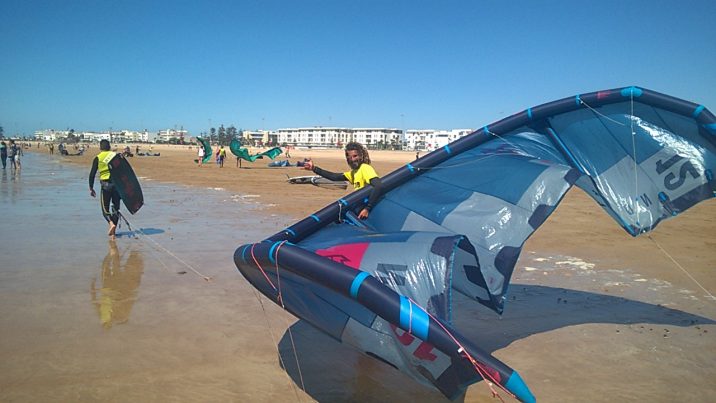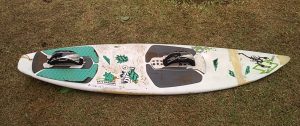So you want to become a kitesurfer. When you ask around, just about everyone has a different estimate about how long it took them to learn to kite. You just want to know what you’re up against, and how fast you’ll be able to enjoy the heavenly feeling of riding the wind!
So how long does it take to learn to kitesurf really? With riding upwind as a goal, it should take you between 15 and 20 hours to learn to kitesurf, including instructor training. Actual learning time will depend on your learning skills, fitness level, wind and water conditions, the frequency of your sessions, and the quality of your instruction.
So basically, if you really set your mind to it and have access to the right conditions and instructor, what they say is true: you can really learn to kiteboard in a few days.
Let’s break this down a little and look at the steps involved and how much time each typically involves.
Note: to learn more about the cost of getting into kiteboarding, check out this post. For more about self-teaching, see can I teach myself to kitesurf?. For information on how to choose a kitesurf school, see this post.
Flying and security: instructor lesson (3 hours)
The first thing you need to learn is how the wind works and how to fly a kite. You’ll probably start with a trainer kite, which is a small, low power kite that you just maneuver with your hands, without a harness.
You learn basic wind theory. You generally need no more than about half an hour to get become familiar with flying a small kite, learning to turn it around, giving it power and feeling the traction.
Then you move on to an actual kitesurf kite which has the power to pull you and requires you to wear a harness around your waist to tie the lines on.
You learn to set up your kite and lines, how to launch the kite and fly it in the neutral and power zones, how to land your kite safely, and how to depower the kite and use the quick release emergency feature.
Body dragging: instructor lesson (3 hours)
The next chunk of learning is body dragging, which is getting dragged by your kite in the water without a board in a controlled way and direction. This is often an exhausting step, particularly if the wind is strong or gusty. That’s where the rubber hits the road: while flying the kite on the beach was fun, this gets a bit more intimidating.
Here you learn to get into the water with your kite up, get yourself dragged downwind, left and right, away from and back toward the shore. You learn to steer your kite with one hand, exit the water at a given point, relaunch your kite after crashing it, and control your kite unhooked (bar detached from harness).
You also learn some essential self-rescue techniques. This step typically requires another 3 hours of intense guided instruction with full safety gear (floating vest, helmet etc). You’ll spend a portion of this time walking back up against the wind on the beach since the body dragging will generally take you far down the beach (downwind).
Water start: instructor lesson (3 hours)
This part of the kitesurf learning process involves using your kiteboard. This is a tricky step because at this point you most learners don’t completely control their kite yet, especially when in the water, yet now you have a new major thing to worry about: your board.
3 hours is barely enough to master this step, but it still gives you good enough exposure so you can later continue on your own.
Here you learn to get in the water with your board in your hand, put yourself in water start position with your feet in the straps while controlling the kite position thtough the bar, powering your kite to get pulled into standing position on your board, staying up and riding forward a moment, recovering your board through upwind body drag.
You also get used to riding your board in both directions, which for some people feels unnatural and requires some practice.
In this step, you typically end up even further down the beach than in the previous step, because of the many attempts to get riding on your board. So again, expect to do a lot more walking upwind on the beach with your kite up pulling you backward!
A lot of time wasted walking, but unless you have someone pick you up in a buggy or something, that’s an unavoidable part of the learning process.
Actual riding: instructor lesson (3 hours)
At this stage you’re done with most the grunt work, now you’re ready to start having some fun. Some people actually decide to do this step on their own – in my case, I did it under instructor supervision (see can I teach myself kitesurfing?)
As you already kind of master the water start, this step mainly involves riding. However, you initially still can’t ride upwind, so you’re only riding downwind and not going back up – which again spells long tedious walks back up on the beach with your kite pulling on your harness in the opposite direction! Over half your time goes into this.
Here you learn to improve your body position, board stance, and leg pressure to edge your board and maintain power in your kite following your water start. You practice riding downwind without losing too much power to avoid your kite dropping, a big step as beginners tend to ride in the same direction as the kite thus losing all tension in their lines.
Again, you’ll waste a lot of time walking back up, getting back into the water, and doing a new water start, so you’ll have very little effective riding time to work on your stance and edging (pushing your board upwind opposite your lines direction).
Riding upwind (3 to 8 hours!)
So at this point, you’ve spent about 12 hours training your brain and muscles to power and depower the kite, get yourself pulled in a controlled way in the water, and get up and stay up for a moment on that board while enjoying the traction in your harness. You should be totally hooked by now (no pun intended)!
BUT … Your last major challenge is learning to ride upwind. You’re really getting tired of spending the major part of your sessions walking up the beach. Plus, you feel a bit dumb walking while all these more experienced kitesurfers ride away without leaving the water for hours!
Be aware that this is where many people actually give up, even though they’ve done all the hard work. The thing is, up to this step, the learning process and time are quite predictable for most people: give or take a couple hours, most people can learn to ride downwind within the above time frames.
For riding upwind, however, things can be more variable. You must reach this aha moment when things align and your body suddenly understands how to maintain tension in your kite lines and how to really push your board upwind. There are a few factors which can delay this heavenly event :
- As mentioned, you get very little effective practice time between beach upwind walks
- You rarely get perfect conditions with flat water and constant yet sufficient wind
- Most people don’t have hours free every day or week for kitesurf practice
- Not everyone has kitesurfer friends who can give laser focused tips on how to stay upwind
The good news is, you’re not the first kitesurfing learner to go through this, and you can tell most kitesurf learners – girls and boys, young and old, big and small, end up getting the hang of it. So you know for sure you will too, the question is just, how much time will it take!
As a ballpark, you’ll probably succeed in getting upwind within 3 to 8 more hours of independent practice (including beach walks!) Things will probably go much faster, though, if you have previous experience sailing, windsurf, wakeboarding or even surfing (sometimes).
Beginner kitesurfing tips to learn faster
To wrap up, I have a couple of final tips for you that can help cut down your learning curve :
- Once you’ve finished going through the above steps with an instructor, ask your school if you can pair up with another learner of the same level, rent one kite, one board and 2 harnesses (+ 2 helmets and vests), and take turns to both practice riding upwind, helping each other walk back up for as long as needed.
- Plan to do several independent kitesurf sessions right after you’ve finished your last guided lesson (or the next day), so your body and brain are still fresh from the training and you can build on that right away. If you wait for too long, you may have to start part of the process all over – although much faster.
- If you can, plan a trip to a kitesurfing location famous for its favorable wind – meaning steady onshore or sideshore winds between 15-25 knots, if possible in a lagoon or lake surrounded with sandbanks, with a wide beach to launch and land your kite. This will be well worth the investment and can really speed up your learning curve!
Learning to kitesurf is not easy, but compared to other sports (e.g. surfing, which takes months), it’s fast! If you’re not sure whether it’s a sport for you, check out my post can anyone learn to kitesurf?
I’ve been there. the feeling is exhilarating. Ride on!



